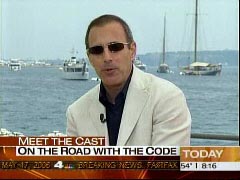 |
|||||||||||||||
|
|||||||||||||||
 |
||
|
 |
||||||||||||
|
||||||||||||
 |
|||||||||||||||||||||||||||||||||||||||
|
|||||||||||||||||||||||||||||||||||||||
|

|
THE TRASHING OF
THE CHRIST By Tim Graham, MRC Director of Media Analysis Executive Summary
The media’s views on religion played a part. In 2004, the networks showed hostility to a more orthodox vision of Jesus in the movie The Passion of the Christ. So MRC analysts compared coverage of the year before The Passion (March 2003 through February 2004) and the year before The DaVinci Code movie (May 19, 2005 through May 18, 2006) on the morning, evening, prime-time and late-night news programs of ABC, CBS, and NBC. Some key findings were: ■ The DaVinci Code received more of a publicity push from the networks than The Passion of the Christ. The number of segments devoted to the movies in the year before their cinematic release was 99 for The DaVinci Code to 66 for The Passion. Most of those came on morning shows. By far, the biggest Code promoter was NBC’s Today, which more provided more stories (38) than the other two network morning shows combined (29). By contrast, NBC was in third-place in Passion segments (11). ■ The Passion of the Christ was treated as a social problem – the biggest TV anti-Semitism story of that year – while The DaVinci Code was presented more often as an "intriguing" theory rather than threatening or offensive to Christians. Nearly every one of the 66 network segments on The Passion on ABC, CBS, and NBC touched on those complaints. But only 27 of the 99 Code segments focused on Christian and Catholic protests. ■ While the faith of millions of Americans, Christianity, is singled out for criticism, with one "fascinating" fictional detail after another, the networks either refused to air or barely aired mild Mohammed cartoons out of great sensitivity to American Muslims. At the same time that Christianity is questioned as a false religion in The DaVinci Code, the networks demonstrated an exquisite sensitivity to American Muslims on the sensitive subject of threatened violence against mostly mild Danish cartoons mocking the prophet Muhammad. ABC aired a glance at one cartoon on two programs. CBS and NBC declared they would censor the images. ■ In their push to promote The DaVinci Code, the networks routinely failed to address how the book most offended Christian sensitivities: that Christianity itself is a lie. The networks showed their lack of belief or interest in religion as they almost always failed to examine Brown’s most contentious charge: that Jesus was not the Son of God. While many noted the scandalous claim of a sexual relationship between Jesus and Mary Magdalene, only six stories explained the Code’s denial of the divinity of Jesus. ■ While Mel Gibson was attacked and even psychoanalyzed for his religious beliefs, DaVinci Code author Dan Brown and filmmakers Ron Howard and Brian Grazer were never personally examined or challenged about their personal religious beliefs, their willingness to milk controversy, play fast and loose with facts, and offend Christians for personal gain. Whenever the networks decided to address fact and fiction in The DaVinci Code, they almost always found it was stuffed with falsehoods. But they never focused on the idea that Brown, Grazer, or Howard should be criticized for being too casual with the truth. ■ The networks also bought into the DaVinci Code craze by picking up and publicizing other Code-related books attacking Christianity and the Catholic Church, but their standard of evidence was hardly an example of what a skeptical journalist would apply. Authors of new books like The Jesus Papers and The Jesus Dynasty were offered publicity forums, even though the network journalists pronounced the evidence behind the claims was flimsy, even non-existent. So why did the networks promote them? The report concludes that one reason for the commercial success of The DaVinci Code movie (as well as the book) was very aggressive salesmanship on the part of the network news divisions. "Network television news stars may boast at seminars that they are tough on everyone, but in real life, their devotion to secularism is almost religious in its intensity."
|
|
The Media Research Center For an interview with an MRC Spokesman, please contact Tim Scheiderer at (703) 683-5004
Home | News Division
| Bozell Columns | CyberAlerts |





 The news media play an important role in popular culture by providing
publicity for the movie studios as films are readied for release. But some
movies are more favored by the news media than others, some for their expected
status as expensive but appealing blockbusters, and some for their social
commentary (for example, the film Brokeback Mountain). The DaVinci
Code was both: an expected blockbuster movie based on one of the most
publicized works of fiction in the new century, drawing enormous national media
interest with its vision of a vast, murderous church conspiracy. It should not
be surprising that The DaVinci Code came roaring out of the box office
with a $77 million opening weekend.
The news media play an important role in popular culture by providing
publicity for the movie studios as films are readied for release. But some
movies are more favored by the news media than others, some for their expected
status as expensive but appealing blockbusters, and some for their social
commentary (for example, the film Brokeback Mountain). The DaVinci
Code was both: an expected blockbuster movie based on one of the most
publicized works of fiction in the new century, drawing enormous national media
interest with its vision of a vast, murderous church conspiracy. It should not
be surprising that The DaVinci Code came roaring out of the box office
with a $77 million opening weekend.